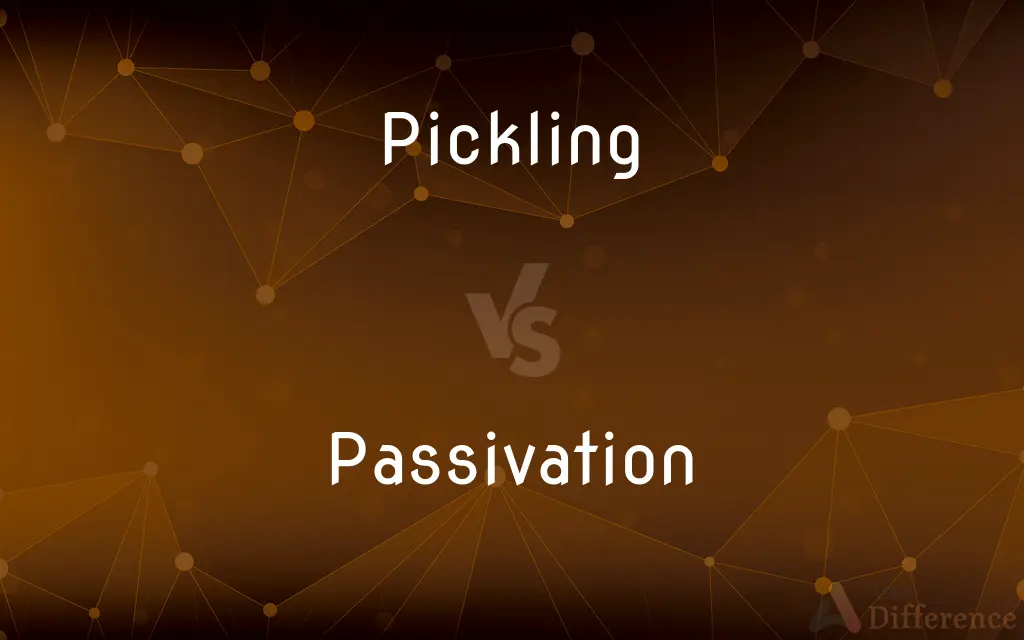Pickling vs. Passivation — What's the Difference?
By Tayyaba Rehman & Fiza Rafique — Updated on April 3, 2024
Pickling removes impurities and scales from metal surfaces through strong acids, while passivation enhances the metal's corrosion resistance by forming a protective oxide layer.

Difference Between Pickling and Passivation
Table of Contents
ADVERTISEMENT
Key Differences
Pickling involves using a chemical solution, typically a strong acid, to remove surface impurities, stains, rust, and scale from metal objects. This process cleans the metal deeply, ensuring that it is free from any contaminants that could affect its performance or durability. On the other hand, passivation, often performed after pickling, uses a milder acid solution to create a thin, protective oxide layer on the surface of stainless steel or other metals, enhancing their natural corrosion resistance.
While pickling can significantly change the appearance of the metal by making it cleaner and sometimes slightly altering its surface texture and appearance, passivation generally does not change the look of the metal significantly. Instead, passivation focuses on improving the metal's resistance to environmental factors that could lead to corrosion.
The process of pickling is more aggressive and can remove a thin layer of metal, exposing a fresh and clean metal surface. Conversely, passivation is a more subtle process that doesn’t remove metal but rather aims to enhance the chromium layer on stainless steel, thereby preventing rust.
Pickling is necessary when metal surfaces are heavily contaminated or have experienced significant corrosion and require a thorough cleaning. Passivation is best suited for metals that have already been cleaned or machined and need an additional protective measure to ensure long-term performance and resistance to corrosion.
Both processes are critical in the metal finishing industry, with pickling serving as a preparatory or corrective step to clean the metal, and passivation as a finishing step to ensure the longevity and durability of the metal, especially in harsh environments.
ADVERTISEMENT
Comparison Chart
Purpose
Removes surface impurities and scales.
Enhances corrosion resistance with a protective layer.
Process
Involves strong acids.
Uses milder acids to form an oxide layer.
Effect on Metal
Can alter surface texture and appearance.
Does not significantly change appearance.
Removal
Removes a layer of metal.
Does not remove metal, focuses on protection.
Suitability
For heavily contaminated or corroded metals.
For cleaned or machined metals requiring protection.
Focus
Deep cleaning of metal surfaces.
Improving resistance to environmental corrosion.
Industry Use
Preparatory or corrective step.
Finishing step for longevity and durability.
Compare with Definitions
Pickling
Removes scale and impurities.
After forging, the metal parts underwent pickling to cleanse them of scale.
Passivation
Forms a protective oxide layer on metal.
After machining, the stainless steel components were passivated to prevent rust.
Pickling
Can slightly alter the metal's appearance.
After pickling, the metal exhibited a matte finish.
Passivation
Enhances metal's corrosion resistance.
Passivation extended the outdoor sculpture's durability against weather elements.
Pickling
Deep cleaning metal surfaces with strong acids.
The sculpture was pickled to remove years of rust and tarnish.
Passivation
Does not change metal appearance significantly.
The passivated parts maintained their shine without altering their color.
Pickling
Necessary for restoring heavily corroded metals.
The antique ironwork required pickling to restore its original look.
Passivation
Finishing step for metals in harsh environments.
Aerospace components undergo passivation for enhanced resistance to corrosion.
Pickling
Prepares metal for further processing.
Before welding, the steel sheets were pickled to ensure a clean joining surface.
Passivation
Uses milder acids compared to pickling.
The passivation process involved treating the metal with citric acid.
Pickling
Pickling is the process of preserving or extending the shelf life of food by either anaerobic fermentation in brine or immersion in vinegar. The pickling procedure typically affects the food's texture and flavor.
Passivation
To treat or coat (a metal) in order to reduce the chemical reactivity of its surface.
Pickling
An edible product, such as a cucumber, that has been preserved and flavored in a solution of brine or vinegar.
Passivation
To coat (a semiconductor, for example) with an oxide layer to protect against contamination and increase electrical stability.
Pickling
A solution of brine or vinegar, often spiced, for preserving and flavoring food.
Passivation
The process of making a material passive (non-reactive) in relation to another material prior to using the materials together.
Pickling
A chemical solution, such as an acid, that is used as a bath to remove scale and oxides from the surface of metals before plating or finishing.
Passivation
(chemistry) The spontaneous formation of a hard non-reactive surface film (usually an oxide or nitride) that inhibits further corrosion.
Pickling
(Informal) A disagreeable or troublesome situation; a plight.
Passivation
(control theory) Conversion of a non-passive dynamical system into a passive one.
Pickling
(Baseball) A rundown.
Pickling
To preserve or flavor (food) in a solution of brine or vinegar.
Pickling
To treat (metal) in a chemical bath.
Pickling
An instance of processing something in brine or other solution.
Pickling
A process by which the oxide scale on steel (especially stainless steels) or other metallic objects is chemically removed (by strong acids).
Pickling
Present participle of pickle
Common Curiosities
What is pickling in metal processing?
Pickling is the process of removing surface contaminants like rust and scale from metal using strong acid solutions.
How does passivation protect against corrosion?
Passivation protects against corrosion by creating a protective oxide layer that reduces the metal's reactivity with environmental factors.
What does passivation do to metals?
Passivation forms a thin, protective oxide layer on the surface of metals, increasing their resistance to corrosion.
Is pickling necessary for all metals?
Pickling is most beneficial for metals that are heavily contaminated or have a significant buildup of rust and scale.
Can pickling and passivation occur together?
Yes, metals often undergo pickling first to clean the surface, followed by passivation to enhance corrosion resistance.
Can all metals be passivated?
Not all metals benefit from passivation; the process is most effective on metals like stainless steel that can form a protective oxide layer.
What acids are used in pickling and passivation?
Strong acids like hydrochloric or sulfuric acid are used for pickling, while milder acids like nitric or citric acid are used for passivation.
How do you know if a metal needs pickling or passivation?
The need is determined by the metal's condition and the intended use; heavily corroded metals need pickling, while those needing corrosion resistance benefit from passivation.
Are there environmental concerns with pickling and passivation?
Yes, the acids used, especially in pickling, require careful handling and disposal due to environmental and safety concerns.
Is passivation safe for food-contact surfaces?
Yes, when done correctly, passivation is safe for metals used in food processing and preparation surfaces, enhancing their cleanliness and corrosion resistance.
Do pickling and passivation affect metal strength?
While pickling may remove a thin layer of metal, neither process significantly affects the metal's mechanical strength; passivation may actually protect it.
How long does the passivation effect last?
The durability of the passivation layer depends on environmental exposure, but it can significantly prolong the metal's resistance to corrosion.
What is the difference between passivation and galvanization?
Passivation creates a protective oxide layer chemically, while galvanization involves applying a protective zinc coating physically.
What industries use pickling and passivation?
These processes are used in various industries, including construction, automotive, aerospace, and manufacturing.
Can pickling remove all types of surface defects?
Pickling effectively removes most surface contaminants, but some defects may require mechanical or additional chemical processes.
Share Your Discovery

Previous Comparison
Clergy vs. Laity
Next Comparison
Adversity vs. SetbackAuthor Spotlight
Written by
Tayyaba RehmanTayyaba Rehman is a distinguished writer, currently serving as a primary contributor to askdifference.com. As a researcher in semantics and etymology, Tayyaba's passion for the complexity of languages and their distinctions has found a perfect home on the platform. Tayyaba delves into the intricacies of language, distinguishing between commonly confused words and phrases, thereby providing clarity for readers worldwide.
Co-written by
Fiza RafiqueFiza Rafique is a skilled content writer at AskDifference.com, where she meticulously refines and enhances written pieces. Drawing from her vast editorial expertise, Fiza ensures clarity, accuracy, and precision in every article. Passionate about language, she continually seeks to elevate the quality of content for readers worldwide.












































